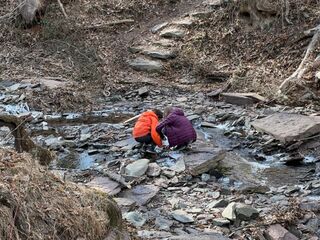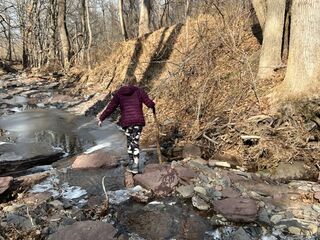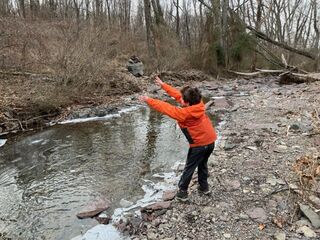Play
How Outdoor Play Leads to Exploration and Quality Family Time
A Sunday dog-walk-turned-adventure shows the value of putting screens away.
Posted January 28, 2022 Reviewed by Ekua Hagan
Key points
- Screen time among children has skyrocketed in recent years, decreasing their pursuit of other activities.
- Outdoor play offers countless benefits for kids, including increased creativity, mental focus, and collaboration.
- Getting kids outside more often will likely show them that natural wonders can be much more entertaining than their iPads.
Last weekend, my husband, two children, and I went to a local park to take our family dog on a walk. I should add the word “begrudgingly” to the previous sentence in reference to my children, who would have preferred to stay home and lounge on the couch with their iPads. But I insisted that some fresh air and exercise, as well as time together as a family and with the dog, would be good for all of us. When we left, I assumed we would be back home in a half-hour or so. As it turns out, our ordinary Sunday dog walk developed into a three-hour family adventure. It was simply awesome.

The effects of increased screen time on kids
I know that I am not alone in concerns about the lure of screens for my children. Screen time among children has certainly skyrocketed in recent years, with the COVID-19 pandemic greatly compounding the problem (Dore et al., 2021; Montag & Elhai, 2020; Richtel, 2021).
And there is indeed a reason for parents to be apprehensive about this significant uptick in time spent absorbed in electronic devices. As children engage in more screen-based activities, other hobbies, and pursuits—including creative free play, physical activities, and achievement-related activities like reading and studying—decline (Hofferth, 2009).
In parallel with an increase in screen time, outdoor play has been on the decline (Pynn et al., 2018). In addition to the temptations of technology, there are other contributors to this drop, including a rise in indoor, structured activities, and an intensified focus on academic preparation. Also, parents today seem to be more concerned about possible “outdoor dangers,” such as pollution, insect-born diseases, a concern that their children will get in trouble, and skin cancer from sun exposure (Kemple et al., 2016).
Children who do not get as much outdoor play may indeed be “missing out.” Outdoor play offers countless benefits including (but certainly not limited to) increases in creativity, mental focus, and collaborative play (Keeler, 2015).

The impact of outdoor play
I witnessed each of the above-named benefits personally as we were on our hike. We had not walked for more than five minutes when the kids began a race with the dog. Shortly after that, they came upon a fallen tree amidst several dead vines, leaves, and clumps of grass. Together, they decided that the elevated log was a seat, and the draping vines natural curtains for their “fort.” Part of the broken tree that was sticking up vertically with some vines/ leaves remaining on it in a mushroom-sort of shape was most certainly a “lamp.” Some long scraps of bark became blades to cut any intruding vines, scrape off unwanted leaves, grass, and twigs, poke at patches of ice, and write in patches of snow.

After about 45 minutes of playing in this natural fort, we convinced them to keep walking along the trail (only after a promise to return in the near future). Soon we came to a small creek, where they spent another half hour rock-hunting, even choosing nice rocks for one another (“I think you’d like this one!”). The collaboration and lack of bickering were such a pleasant break from the norm! At the creek, they also studied ice formations, broke ice formations, and crisscrossed repeatedly between the shores using various stone paths. (Thank you waterproof hiking boots!)


Continuing with the hike, we tiptoed around (or carefully slid on) ice patches, took photos in an open meadow and found a second creek for exploring. At this creek, a fallen log became a good opportunity to practice balancing. My son was given permission to toss some stones, so he gleefully picked up the biggest ones he could handle and set out to crack various ice clumps in order to create “icebergs,” “ice islands,” and “water explosions!”

Honestly, the only reason our excursion ended for the day was our growling stomachs. Thankfully, the trail we were on is only a five-minute drive from our house. I have no doubt that we will return for many more adventures. And next time, we’ll pack a picnic to bring with us.
So, if your family is anything like mine, I encourage you to gently pry the children away from the screens and shoo them outside. Put the dog leash in their hands, and tell them that family time is not optional. Who knows? You may even find that adventure is lurking around the corner from your house, too.


